Global Expansion of Sasol: Strategy, Risk, and Cultural Impact
VerifiedAdded on 2023/06/13
|12
|4073
|479
Report
AI Summary
This report evaluates the impact of globalization on SASOL, applying models like McKinsey's 7S and Hofstede's cultural dimensions to assess changes in structure, culture, and leadership. It examines how SASOL has adapted to operate in the global marketplace, emphasizing ethical and sustainable factors influencing its operations and decision-making. The report also assesses strategic decision making in relation to risk and diversification and explores various international expansion routes available to SASOL, providing a comprehensive overview of the company's global strategy.
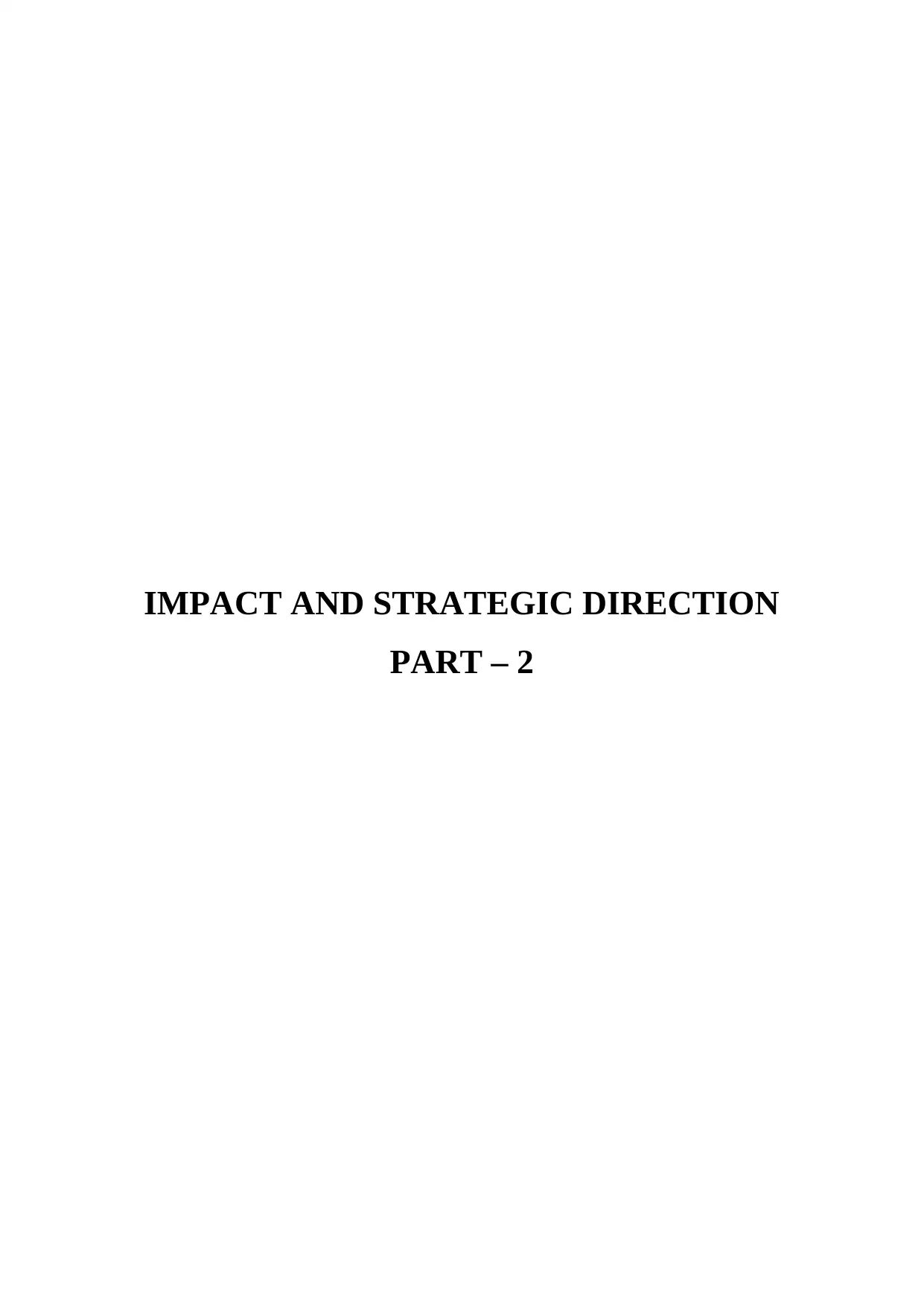
IMPACT AND STRATEGIC DIRECTION
PART – 2
PART – 2
Paraphrase This Document
Need a fresh take? Get an instant paraphrase of this document with our AI Paraphraser
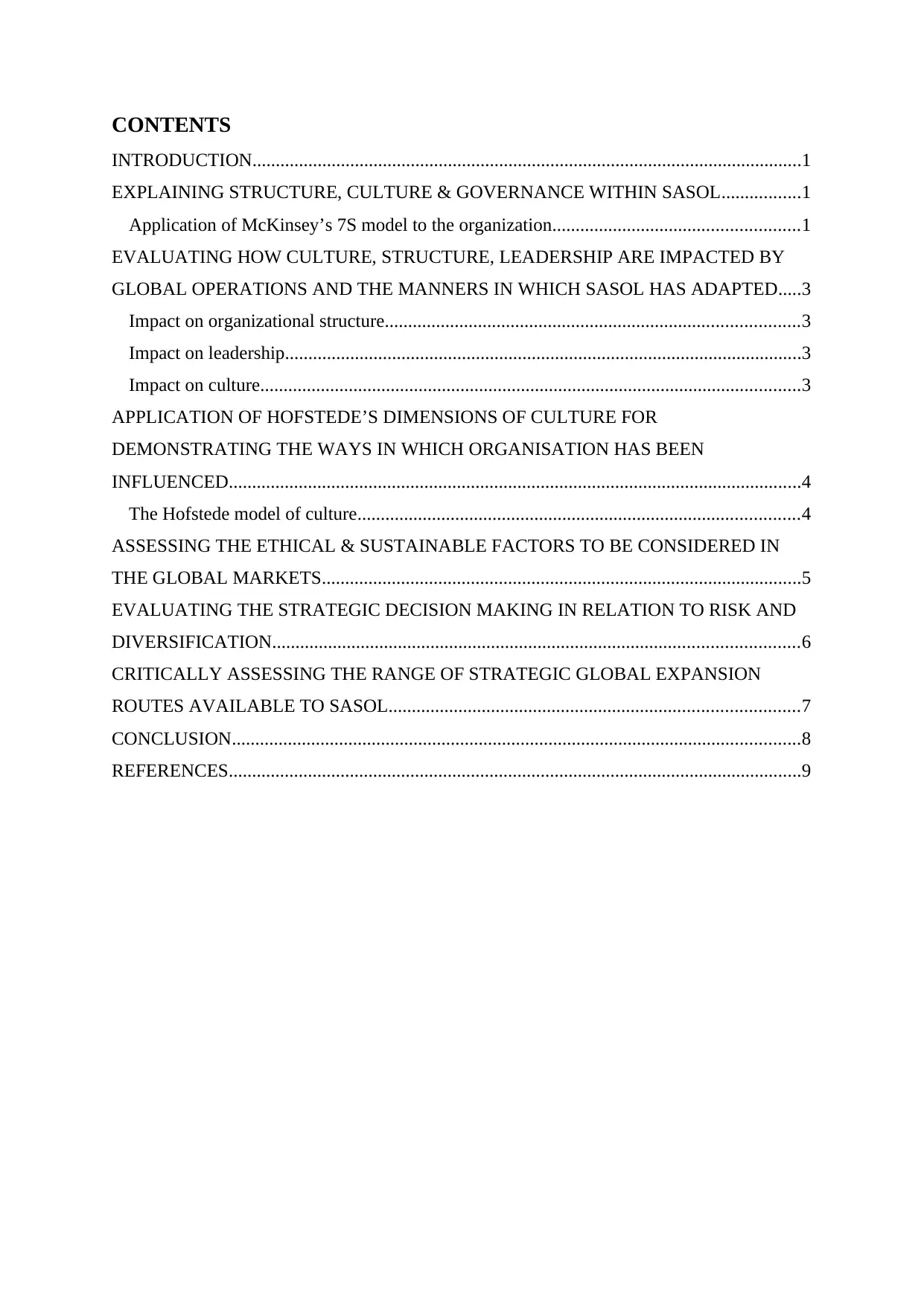
CONTENTS
INTRODUCTION......................................................................................................................1
EXPLAINING STRUCTURE, CULTURE & GOVERNANCE WITHIN SASOL.................1
Application of McKinsey’s 7S model to the organization.....................................................1
EVALUATING HOW CULTURE, STRUCTURE, LEADERSHIP ARE IMPACTED BY
GLOBAL OPERATIONS AND THE MANNERS IN WHICH SASOL HAS ADAPTED.....3
Impact on organizational structure.........................................................................................3
Impact on leadership...............................................................................................................3
Impact on culture....................................................................................................................3
APPLICATION OF HOFSTEDE’S DIMENSIONS OF CULTURE FOR
DEMONSTRATING THE WAYS IN WHICH ORGANISATION HAS BEEN
INFLUENCED...........................................................................................................................4
The Hofstede model of culture...............................................................................................4
ASSESSING THE ETHICAL & SUSTAINABLE FACTORS TO BE CONSIDERED IN
THE GLOBAL MARKETS.......................................................................................................5
EVALUATING THE STRATEGIC DECISION MAKING IN RELATION TO RISK AND
DIVERSIFICATION.................................................................................................................6
CRITICALLY ASSESSING THE RANGE OF STRATEGIC GLOBAL EXPANSION
ROUTES AVAILABLE TO SASOL........................................................................................7
CONCLUSION..........................................................................................................................8
REFERENCES...........................................................................................................................9
INTRODUCTION......................................................................................................................1
EXPLAINING STRUCTURE, CULTURE & GOVERNANCE WITHIN SASOL.................1
Application of McKinsey’s 7S model to the organization.....................................................1
EVALUATING HOW CULTURE, STRUCTURE, LEADERSHIP ARE IMPACTED BY
GLOBAL OPERATIONS AND THE MANNERS IN WHICH SASOL HAS ADAPTED.....3
Impact on organizational structure.........................................................................................3
Impact on leadership...............................................................................................................3
Impact on culture....................................................................................................................3
APPLICATION OF HOFSTEDE’S DIMENSIONS OF CULTURE FOR
DEMONSTRATING THE WAYS IN WHICH ORGANISATION HAS BEEN
INFLUENCED...........................................................................................................................4
The Hofstede model of culture...............................................................................................4
ASSESSING THE ETHICAL & SUSTAINABLE FACTORS TO BE CONSIDERED IN
THE GLOBAL MARKETS.......................................................................................................5
EVALUATING THE STRATEGIC DECISION MAKING IN RELATION TO RISK AND
DIVERSIFICATION.................................................................................................................6
CRITICALLY ASSESSING THE RANGE OF STRATEGIC GLOBAL EXPANSION
ROUTES AVAILABLE TO SASOL........................................................................................7
CONCLUSION..........................................................................................................................8
REFERENCES...........................................................................................................................9
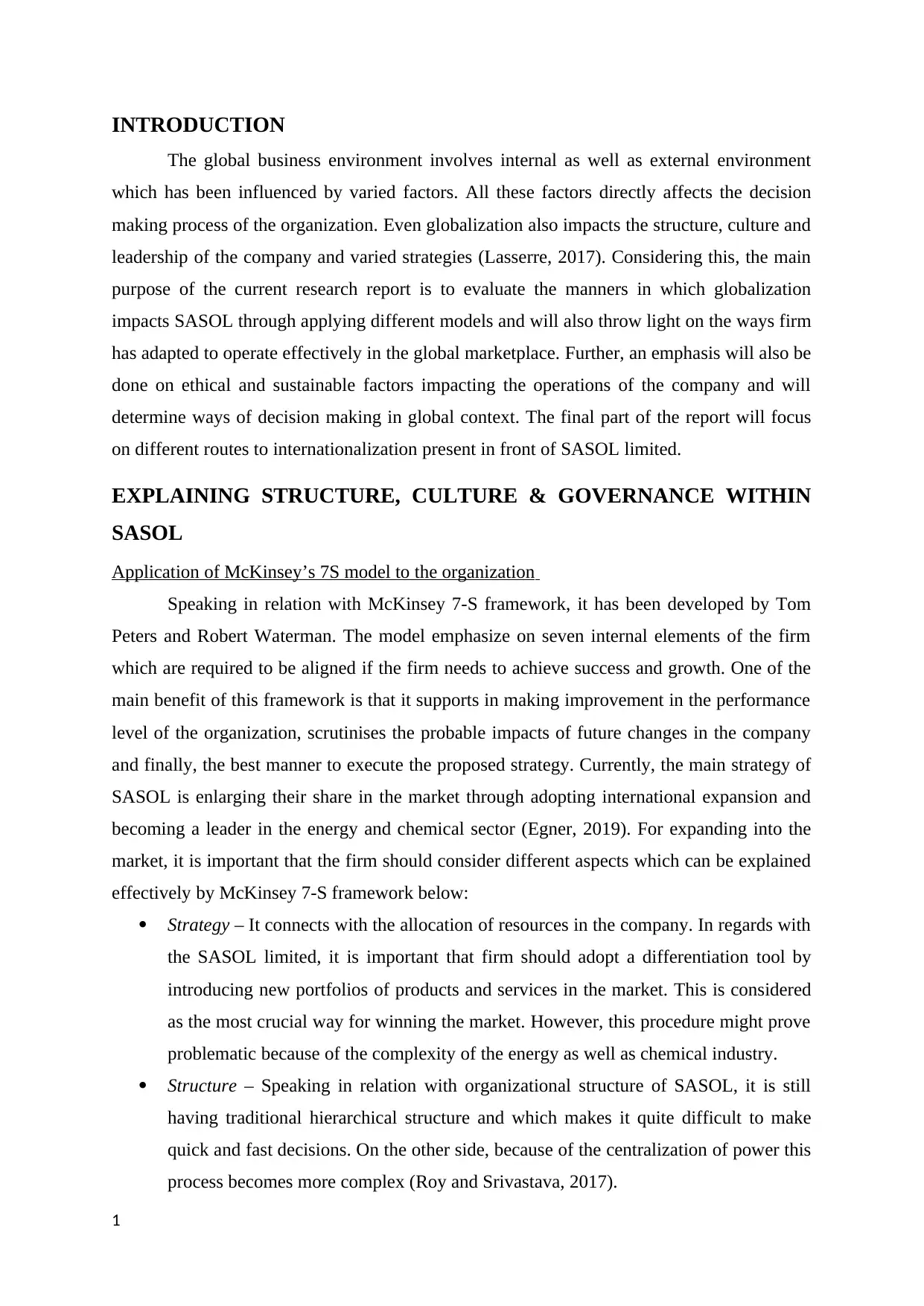
INTRODUCTION
The global business environment involves internal as well as external environment
which has been influenced by varied factors. All these factors directly affects the decision
making process of the organization. Even globalization also impacts the structure, culture and
leadership of the company and varied strategies (Lasserre, 2017). Considering this, the main
purpose of the current research report is to evaluate the manners in which globalization
impacts SASOL through applying different models and will also throw light on the ways firm
has adapted to operate effectively in the global marketplace. Further, an emphasis will also be
done on ethical and sustainable factors impacting the operations of the company and will
determine ways of decision making in global context. The final part of the report will focus
on different routes to internationalization present in front of SASOL limited.
EXPLAINING STRUCTURE, CULTURE & GOVERNANCE WITHIN
SASOL
Application of McKinsey’s 7S model to the organization
Speaking in relation with McKinsey 7-S framework, it has been developed by Tom
Peters and Robert Waterman. The model emphasize on seven internal elements of the firm
which are required to be aligned if the firm needs to achieve success and growth. One of the
main benefit of this framework is that it supports in making improvement in the performance
level of the organization, scrutinises the probable impacts of future changes in the company
and finally, the best manner to execute the proposed strategy. Currently, the main strategy of
SASOL is enlarging their share in the market through adopting international expansion and
becoming a leader in the energy and chemical sector (Egner, 2019). For expanding into the
market, it is important that the firm should consider different aspects which can be explained
effectively by McKinsey 7-S framework below:
Strategy – It connects with the allocation of resources in the company. In regards with
the SASOL limited, it is important that firm should adopt a differentiation tool by
introducing new portfolios of products and services in the market. This is considered
as the most crucial way for winning the market. However, this procedure might prove
problematic because of the complexity of the energy as well as chemical industry.
Structure – Speaking in relation with organizational structure of SASOL, it is still
having traditional hierarchical structure and which makes it quite difficult to make
quick and fast decisions. On the other side, because of the centralization of power this
process becomes more complex (Roy and Srivastava, 2017).
1
The global business environment involves internal as well as external environment
which has been influenced by varied factors. All these factors directly affects the decision
making process of the organization. Even globalization also impacts the structure, culture and
leadership of the company and varied strategies (Lasserre, 2017). Considering this, the main
purpose of the current research report is to evaluate the manners in which globalization
impacts SASOL through applying different models and will also throw light on the ways firm
has adapted to operate effectively in the global marketplace. Further, an emphasis will also be
done on ethical and sustainable factors impacting the operations of the company and will
determine ways of decision making in global context. The final part of the report will focus
on different routes to internationalization present in front of SASOL limited.
EXPLAINING STRUCTURE, CULTURE & GOVERNANCE WITHIN
SASOL
Application of McKinsey’s 7S model to the organization
Speaking in relation with McKinsey 7-S framework, it has been developed by Tom
Peters and Robert Waterman. The model emphasize on seven internal elements of the firm
which are required to be aligned if the firm needs to achieve success and growth. One of the
main benefit of this framework is that it supports in making improvement in the performance
level of the organization, scrutinises the probable impacts of future changes in the company
and finally, the best manner to execute the proposed strategy. Currently, the main strategy of
SASOL is enlarging their share in the market through adopting international expansion and
becoming a leader in the energy and chemical sector (Egner, 2019). For expanding into the
market, it is important that the firm should consider different aspects which can be explained
effectively by McKinsey 7-S framework below:
Strategy – It connects with the allocation of resources in the company. In regards with
the SASOL limited, it is important that firm should adopt a differentiation tool by
introducing new portfolios of products and services in the market. This is considered
as the most crucial way for winning the market. However, this procedure might prove
problematic because of the complexity of the energy as well as chemical industry.
Structure – Speaking in relation with organizational structure of SASOL, it is still
having traditional hierarchical structure and which makes it quite difficult to make
quick and fast decisions. On the other side, because of the centralization of power this
process becomes more complex (Roy and Srivastava, 2017).
1
⊘ This is a preview!⊘
Do you want full access?
Subscribe today to unlock all pages.

Trusted by 1+ million students worldwide
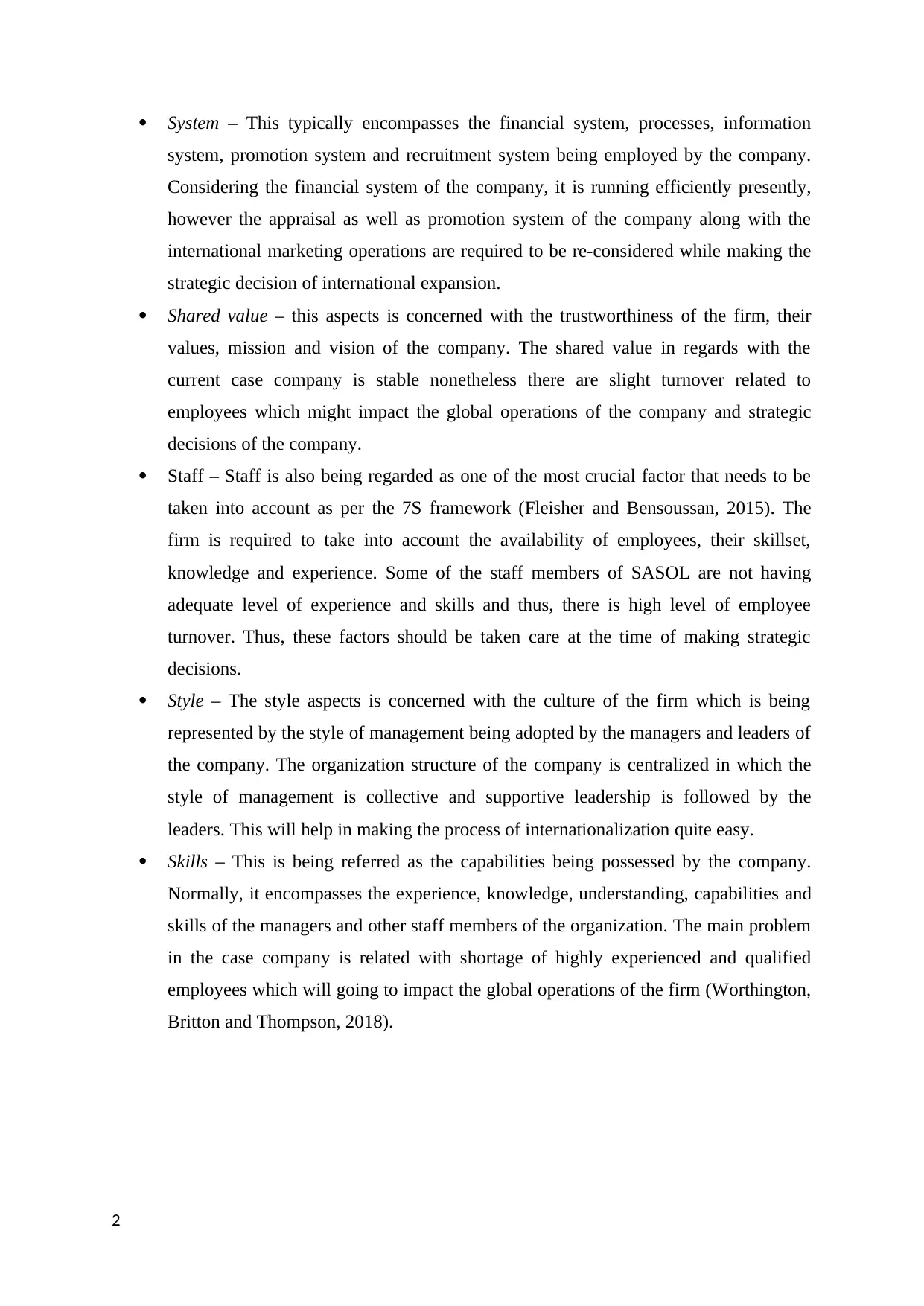
System – This typically encompasses the financial system, processes, information
system, promotion system and recruitment system being employed by the company.
Considering the financial system of the company, it is running efficiently presently,
however the appraisal as well as promotion system of the company along with the
international marketing operations are required to be re-considered while making the
strategic decision of international expansion.
Shared value – this aspects is concerned with the trustworthiness of the firm, their
values, mission and vision of the company. The shared value in regards with the
current case company is stable nonetheless there are slight turnover related to
employees which might impact the global operations of the company and strategic
decisions of the company.
Staff – Staff is also being regarded as one of the most crucial factor that needs to be
taken into account as per the 7S framework (Fleisher and Bensoussan, 2015). The
firm is required to take into account the availability of employees, their skillset,
knowledge and experience. Some of the staff members of SASOL are not having
adequate level of experience and skills and thus, there is high level of employee
turnover. Thus, these factors should be taken care at the time of making strategic
decisions.
Style – The style aspects is concerned with the culture of the firm which is being
represented by the style of management being adopted by the managers and leaders of
the company. The organization structure of the company is centralized in which the
style of management is collective and supportive leadership is followed by the
leaders. This will help in making the process of internationalization quite easy.
Skills – This is being referred as the capabilities being possessed by the company.
Normally, it encompasses the experience, knowledge, understanding, capabilities and
skills of the managers and other staff members of the organization. The main problem
in the case company is related with shortage of highly experienced and qualified
employees which will going to impact the global operations of the firm (Worthington,
Britton and Thompson, 2018).
2
system, promotion system and recruitment system being employed by the company.
Considering the financial system of the company, it is running efficiently presently,
however the appraisal as well as promotion system of the company along with the
international marketing operations are required to be re-considered while making the
strategic decision of international expansion.
Shared value – this aspects is concerned with the trustworthiness of the firm, their
values, mission and vision of the company. The shared value in regards with the
current case company is stable nonetheless there are slight turnover related to
employees which might impact the global operations of the company and strategic
decisions of the company.
Staff – Staff is also being regarded as one of the most crucial factor that needs to be
taken into account as per the 7S framework (Fleisher and Bensoussan, 2015). The
firm is required to take into account the availability of employees, their skillset,
knowledge and experience. Some of the staff members of SASOL are not having
adequate level of experience and skills and thus, there is high level of employee
turnover. Thus, these factors should be taken care at the time of making strategic
decisions.
Style – The style aspects is concerned with the culture of the firm which is being
represented by the style of management being adopted by the managers and leaders of
the company. The organization structure of the company is centralized in which the
style of management is collective and supportive leadership is followed by the
leaders. This will help in making the process of internationalization quite easy.
Skills – This is being referred as the capabilities being possessed by the company.
Normally, it encompasses the experience, knowledge, understanding, capabilities and
skills of the managers and other staff members of the organization. The main problem
in the case company is related with shortage of highly experienced and qualified
employees which will going to impact the global operations of the firm (Worthington,
Britton and Thompson, 2018).
2
Paraphrase This Document
Need a fresh take? Get an instant paraphrase of this document with our AI Paraphraser
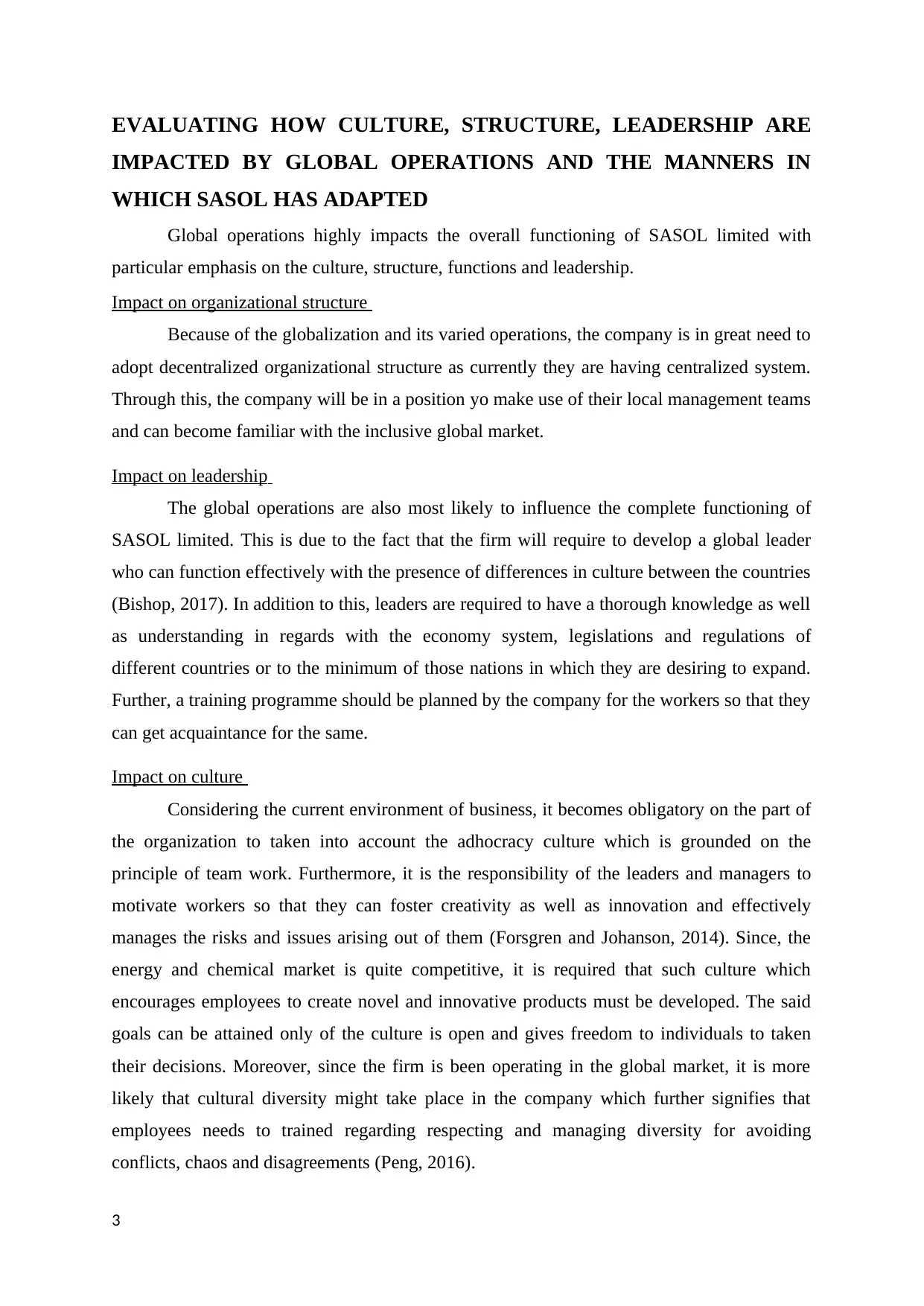
EVALUATING HOW CULTURE, STRUCTURE, LEADERSHIP ARE
IMPACTED BY GLOBAL OPERATIONS AND THE MANNERS IN
WHICH SASOL HAS ADAPTED
Global operations highly impacts the overall functioning of SASOL limited with
particular emphasis on the culture, structure, functions and leadership.
Impact on organizational structure
Because of the globalization and its varied operations, the company is in great need to
adopt decentralized organizational structure as currently they are having centralized system.
Through this, the company will be in a position yo make use of their local management teams
and can become familiar with the inclusive global market.
Impact on leadership
The global operations are also most likely to influence the complete functioning of
SASOL limited. This is due to the fact that the firm will require to develop a global leader
who can function effectively with the presence of differences in culture between the countries
(Bishop, 2017). In addition to this, leaders are required to have a thorough knowledge as well
as understanding in regards with the economy system, legislations and regulations of
different countries or to the minimum of those nations in which they are desiring to expand.
Further, a training programme should be planned by the company for the workers so that they
can get acquaintance for the same.
Impact on culture
Considering the current environment of business, it becomes obligatory on the part of
the organization to taken into account the adhocracy culture which is grounded on the
principle of team work. Furthermore, it is the responsibility of the leaders and managers to
motivate workers so that they can foster creativity as well as innovation and effectively
manages the risks and issues arising out of them (Forsgren and Johanson, 2014). Since, the
energy and chemical market is quite competitive, it is required that such culture which
encourages employees to create novel and innovative products must be developed. The said
goals can be attained only of the culture is open and gives freedom to individuals to taken
their decisions. Moreover, since the firm is been operating in the global market, it is more
likely that cultural diversity might take place in the company which further signifies that
employees needs to trained regarding respecting and managing diversity for avoiding
conflicts, chaos and disagreements (Peng, 2016).
3
IMPACTED BY GLOBAL OPERATIONS AND THE MANNERS IN
WHICH SASOL HAS ADAPTED
Global operations highly impacts the overall functioning of SASOL limited with
particular emphasis on the culture, structure, functions and leadership.
Impact on organizational structure
Because of the globalization and its varied operations, the company is in great need to
adopt decentralized organizational structure as currently they are having centralized system.
Through this, the company will be in a position yo make use of their local management teams
and can become familiar with the inclusive global market.
Impact on leadership
The global operations are also most likely to influence the complete functioning of
SASOL limited. This is due to the fact that the firm will require to develop a global leader
who can function effectively with the presence of differences in culture between the countries
(Bishop, 2017). In addition to this, leaders are required to have a thorough knowledge as well
as understanding in regards with the economy system, legislations and regulations of
different countries or to the minimum of those nations in which they are desiring to expand.
Further, a training programme should be planned by the company for the workers so that they
can get acquaintance for the same.
Impact on culture
Considering the current environment of business, it becomes obligatory on the part of
the organization to taken into account the adhocracy culture which is grounded on the
principle of team work. Furthermore, it is the responsibility of the leaders and managers to
motivate workers so that they can foster creativity as well as innovation and effectively
manages the risks and issues arising out of them (Forsgren and Johanson, 2014). Since, the
energy and chemical market is quite competitive, it is required that such culture which
encourages employees to create novel and innovative products must be developed. The said
goals can be attained only of the culture is open and gives freedom to individuals to taken
their decisions. Moreover, since the firm is been operating in the global market, it is more
likely that cultural diversity might take place in the company which further signifies that
employees needs to trained regarding respecting and managing diversity for avoiding
conflicts, chaos and disagreements (Peng, 2016).
3
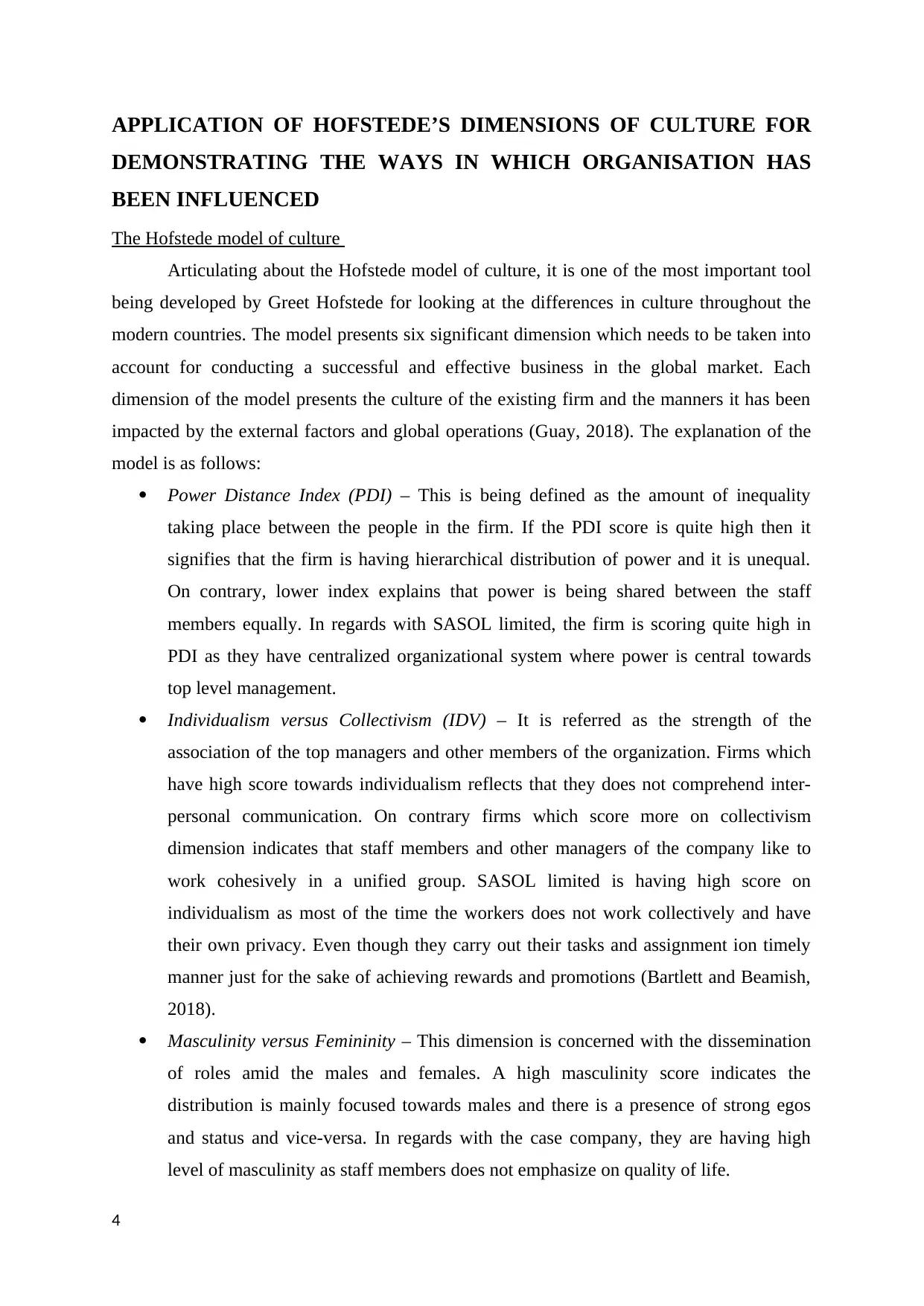
APPLICATION OF HOFSTEDE’S DIMENSIONS OF CULTURE FOR
DEMONSTRATING THE WAYS IN WHICH ORGANISATION HAS
BEEN INFLUENCED
The Hofstede model of culture
Articulating about the Hofstede model of culture, it is one of the most important tool
being developed by Greet Hofstede for looking at the differences in culture throughout the
modern countries. The model presents six significant dimension which needs to be taken into
account for conducting a successful and effective business in the global market. Each
dimension of the model presents the culture of the existing firm and the manners it has been
impacted by the external factors and global operations (Guay, 2018). The explanation of the
model is as follows:
Power Distance Index (PDI) – This is being defined as the amount of inequality
taking place between the people in the firm. If the PDI score is quite high then it
signifies that the firm is having hierarchical distribution of power and it is unequal.
On contrary, lower index explains that power is being shared between the staff
members equally. In regards with SASOL limited, the firm is scoring quite high in
PDI as they have centralized organizational system where power is central towards
top level management.
Individualism versus Collectivism (IDV) – It is referred as the strength of the
association of the top managers and other members of the organization. Firms which
have high score towards individualism reflects that they does not comprehend inter-
personal communication. On contrary firms which score more on collectivism
dimension indicates that staff members and other managers of the company like to
work cohesively in a unified group. SASOL limited is having high score on
individualism as most of the time the workers does not work collectively and have
their own privacy. Even though they carry out their tasks and assignment ion timely
manner just for the sake of achieving rewards and promotions (Bartlett and Beamish,
2018).
Masculinity versus Femininity – This dimension is concerned with the dissemination
of roles amid the males and females. A high masculinity score indicates the
distribution is mainly focused towards males and there is a presence of strong egos
and status and vice-versa. In regards with the case company, they are having high
level of masculinity as staff members does not emphasize on quality of life.
4
DEMONSTRATING THE WAYS IN WHICH ORGANISATION HAS
BEEN INFLUENCED
The Hofstede model of culture
Articulating about the Hofstede model of culture, it is one of the most important tool
being developed by Greet Hofstede for looking at the differences in culture throughout the
modern countries. The model presents six significant dimension which needs to be taken into
account for conducting a successful and effective business in the global market. Each
dimension of the model presents the culture of the existing firm and the manners it has been
impacted by the external factors and global operations (Guay, 2018). The explanation of the
model is as follows:
Power Distance Index (PDI) – This is being defined as the amount of inequality
taking place between the people in the firm. If the PDI score is quite high then it
signifies that the firm is having hierarchical distribution of power and it is unequal.
On contrary, lower index explains that power is being shared between the staff
members equally. In regards with SASOL limited, the firm is scoring quite high in
PDI as they have centralized organizational system where power is central towards
top level management.
Individualism versus Collectivism (IDV) – It is referred as the strength of the
association of the top managers and other members of the organization. Firms which
have high score towards individualism reflects that they does not comprehend inter-
personal communication. On contrary firms which score more on collectivism
dimension indicates that staff members and other managers of the company like to
work cohesively in a unified group. SASOL limited is having high score on
individualism as most of the time the workers does not work collectively and have
their own privacy. Even though they carry out their tasks and assignment ion timely
manner just for the sake of achieving rewards and promotions (Bartlett and Beamish,
2018).
Masculinity versus Femininity – This dimension is concerned with the dissemination
of roles amid the males and females. A high masculinity score indicates the
distribution is mainly focused towards males and there is a presence of strong egos
and status and vice-versa. In regards with the case company, they are having high
level of masculinity as staff members does not emphasize on quality of life.
4
⊘ This is a preview!⊘
Do you want full access?
Subscribe today to unlock all pages.

Trusted by 1+ million students worldwide
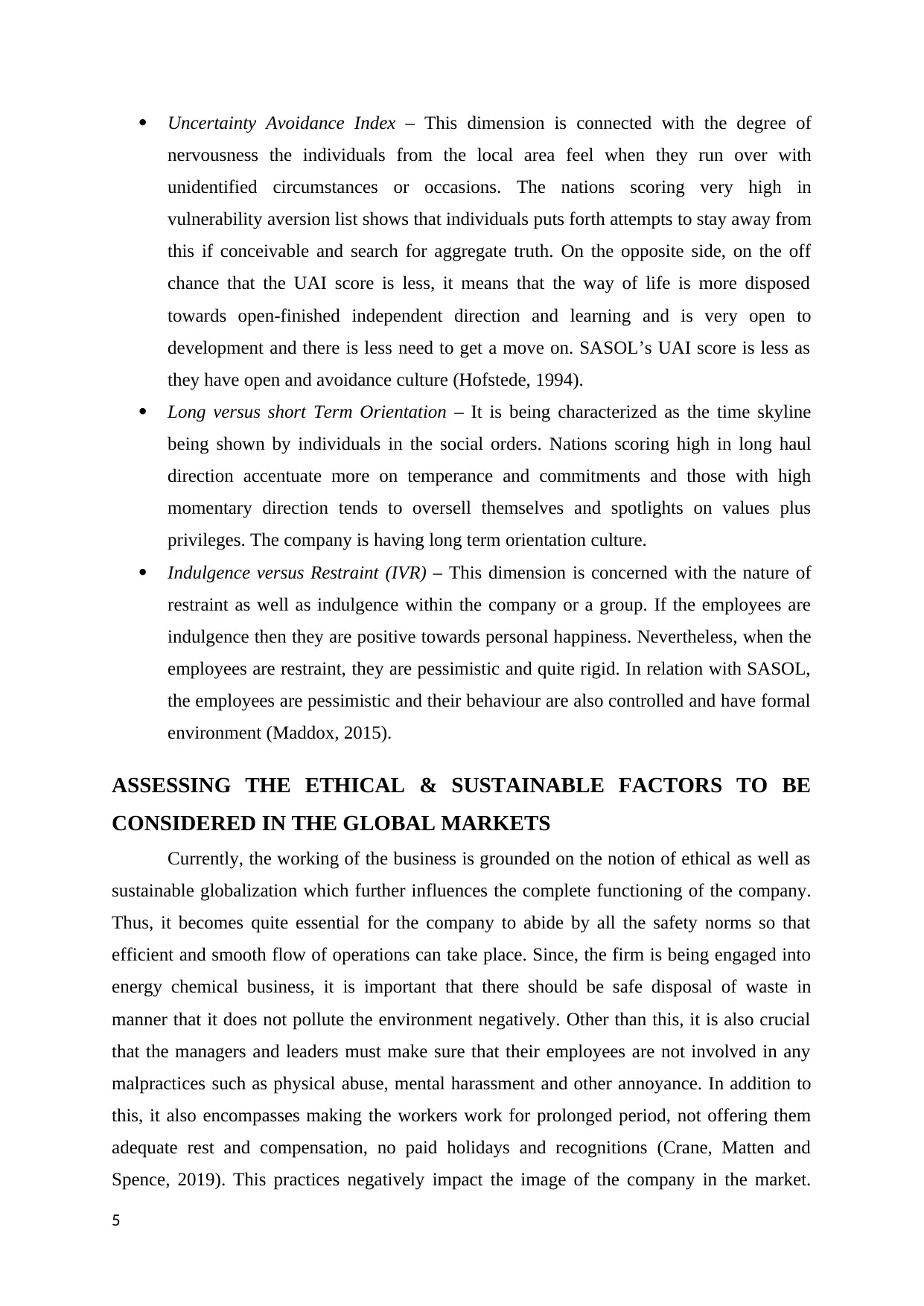
Uncertainty Avoidance Index – This dimension is connected with the degree of
nervousness the individuals from the local area feel when they run over with
unidentified circumstances or occasions. The nations scoring very high in
vulnerability aversion list shows that individuals puts forth attempts to stay away from
this if conceivable and search for aggregate truth. On the opposite side, on the off
chance that the UAI score is less, it means that the way of life is more disposed
towards open-finished independent direction and learning and is very open to
development and there is less need to get a move on. SASOL’s UAI score is less as
they have open and avoidance culture (Hofstede, 1994).
Long versus short Term Orientation – It is being characterized as the time skyline
being shown by individuals in the social orders. Nations scoring high in long haul
direction accentuate more on temperance and commitments and those with high
momentary direction tends to oversell themselves and spotlights on values plus
privileges. The company is having long term orientation culture.
Indulgence versus Restraint (IVR) – This dimension is concerned with the nature of
restraint as well as indulgence within the company or a group. If the employees are
indulgence then they are positive towards personal happiness. Nevertheless, when the
employees are restraint, they are pessimistic and quite rigid. In relation with SASOL,
the employees are pessimistic and their behaviour are also controlled and have formal
environment (Maddox, 2015).
ASSESSING THE ETHICAL & SUSTAINABLE FACTORS TO BE
CONSIDERED IN THE GLOBAL MARKETS
Currently, the working of the business is grounded on the notion of ethical as well as
sustainable globalization which further influences the complete functioning of the company.
Thus, it becomes quite essential for the company to abide by all the safety norms so that
efficient and smooth flow of operations can take place. Since, the firm is being engaged into
energy chemical business, it is important that there should be safe disposal of waste in
manner that it does not pollute the environment negatively. Other than this, it is also crucial
that the managers and leaders must make sure that their employees are not involved in any
malpractices such as physical abuse, mental harassment and other annoyance. In addition to
this, it also encompasses making the workers work for prolonged period, not offering them
adequate rest and compensation, no paid holidays and recognitions (Crane, Matten and
Spence, 2019). This practices negatively impact the image of the company in the market.
5
nervousness the individuals from the local area feel when they run over with
unidentified circumstances or occasions. The nations scoring very high in
vulnerability aversion list shows that individuals puts forth attempts to stay away from
this if conceivable and search for aggregate truth. On the opposite side, on the off
chance that the UAI score is less, it means that the way of life is more disposed
towards open-finished independent direction and learning and is very open to
development and there is less need to get a move on. SASOL’s UAI score is less as
they have open and avoidance culture (Hofstede, 1994).
Long versus short Term Orientation – It is being characterized as the time skyline
being shown by individuals in the social orders. Nations scoring high in long haul
direction accentuate more on temperance and commitments and those with high
momentary direction tends to oversell themselves and spotlights on values plus
privileges. The company is having long term orientation culture.
Indulgence versus Restraint (IVR) – This dimension is concerned with the nature of
restraint as well as indulgence within the company or a group. If the employees are
indulgence then they are positive towards personal happiness. Nevertheless, when the
employees are restraint, they are pessimistic and quite rigid. In relation with SASOL,
the employees are pessimistic and their behaviour are also controlled and have formal
environment (Maddox, 2015).
ASSESSING THE ETHICAL & SUSTAINABLE FACTORS TO BE
CONSIDERED IN THE GLOBAL MARKETS
Currently, the working of the business is grounded on the notion of ethical as well as
sustainable globalization which further influences the complete functioning of the company.
Thus, it becomes quite essential for the company to abide by all the safety norms so that
efficient and smooth flow of operations can take place. Since, the firm is being engaged into
energy chemical business, it is important that there should be safe disposal of waste in
manner that it does not pollute the environment negatively. Other than this, it is also crucial
that the managers and leaders must make sure that their employees are not involved in any
malpractices such as physical abuse, mental harassment and other annoyance. In addition to
this, it also encompasses making the workers work for prolonged period, not offering them
adequate rest and compensation, no paid holidays and recognitions (Crane, Matten and
Spence, 2019). This practices negatively impact the image of the company in the market.
5
Paraphrase This Document
Need a fresh take? Get an instant paraphrase of this document with our AI Paraphraser
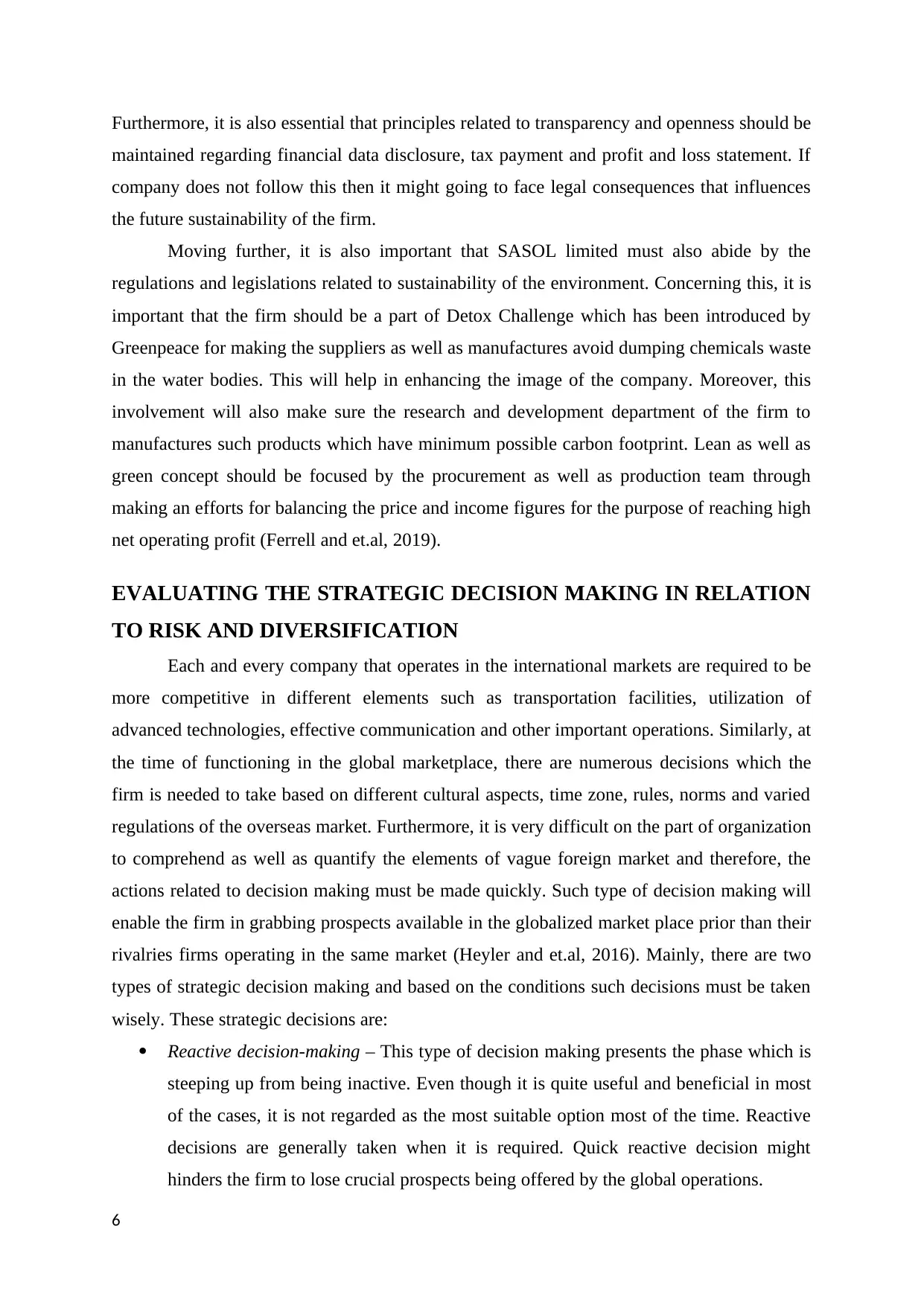
Furthermore, it is also essential that principles related to transparency and openness should be
maintained regarding financial data disclosure, tax payment and profit and loss statement. If
company does not follow this then it might going to face legal consequences that influences
the future sustainability of the firm.
Moving further, it is also important that SASOL limited must also abide by the
regulations and legislations related to sustainability of the environment. Concerning this, it is
important that the firm should be a part of Detox Challenge which has been introduced by
Greenpeace for making the suppliers as well as manufactures avoid dumping chemicals waste
in the water bodies. This will help in enhancing the image of the company. Moreover, this
involvement will also make sure the research and development department of the firm to
manufactures such products which have minimum possible carbon footprint. Lean as well as
green concept should be focused by the procurement as well as production team through
making an efforts for balancing the price and income figures for the purpose of reaching high
net operating profit (Ferrell and et.al, 2019).
EVALUATING THE STRATEGIC DECISION MAKING IN RELATION
TO RISK AND DIVERSIFICATION
Each and every company that operates in the international markets are required to be
more competitive in different elements such as transportation facilities, utilization of
advanced technologies, effective communication and other important operations. Similarly, at
the time of functioning in the global marketplace, there are numerous decisions which the
firm is needed to take based on different cultural aspects, time zone, rules, norms and varied
regulations of the overseas market. Furthermore, it is very difficult on the part of organization
to comprehend as well as quantify the elements of vague foreign market and therefore, the
actions related to decision making must be made quickly. Such type of decision making will
enable the firm in grabbing prospects available in the globalized market place prior than their
rivalries firms operating in the same market (Heyler and et.al, 2016). Mainly, there are two
types of strategic decision making and based on the conditions such decisions must be taken
wisely. These strategic decisions are:
Reactive decision-making – This type of decision making presents the phase which is
steeping up from being inactive. Even though it is quite useful and beneficial in most
of the cases, it is not regarded as the most suitable option most of the time. Reactive
decisions are generally taken when it is required. Quick reactive decision might
hinders the firm to lose crucial prospects being offered by the global operations.
6
maintained regarding financial data disclosure, tax payment and profit and loss statement. If
company does not follow this then it might going to face legal consequences that influences
the future sustainability of the firm.
Moving further, it is also important that SASOL limited must also abide by the
regulations and legislations related to sustainability of the environment. Concerning this, it is
important that the firm should be a part of Detox Challenge which has been introduced by
Greenpeace for making the suppliers as well as manufactures avoid dumping chemicals waste
in the water bodies. This will help in enhancing the image of the company. Moreover, this
involvement will also make sure the research and development department of the firm to
manufactures such products which have minimum possible carbon footprint. Lean as well as
green concept should be focused by the procurement as well as production team through
making an efforts for balancing the price and income figures for the purpose of reaching high
net operating profit (Ferrell and et.al, 2019).
EVALUATING THE STRATEGIC DECISION MAKING IN RELATION
TO RISK AND DIVERSIFICATION
Each and every company that operates in the international markets are required to be
more competitive in different elements such as transportation facilities, utilization of
advanced technologies, effective communication and other important operations. Similarly, at
the time of functioning in the global marketplace, there are numerous decisions which the
firm is needed to take based on different cultural aspects, time zone, rules, norms and varied
regulations of the overseas market. Furthermore, it is very difficult on the part of organization
to comprehend as well as quantify the elements of vague foreign market and therefore, the
actions related to decision making must be made quickly. Such type of decision making will
enable the firm in grabbing prospects available in the globalized market place prior than their
rivalries firms operating in the same market (Heyler and et.al, 2016). Mainly, there are two
types of strategic decision making and based on the conditions such decisions must be taken
wisely. These strategic decisions are:
Reactive decision-making – This type of decision making presents the phase which is
steeping up from being inactive. Even though it is quite useful and beneficial in most
of the cases, it is not regarded as the most suitable option most of the time. Reactive
decisions are generally taken when it is required. Quick reactive decision might
hinders the firm to lose crucial prospects being offered by the global operations.
6
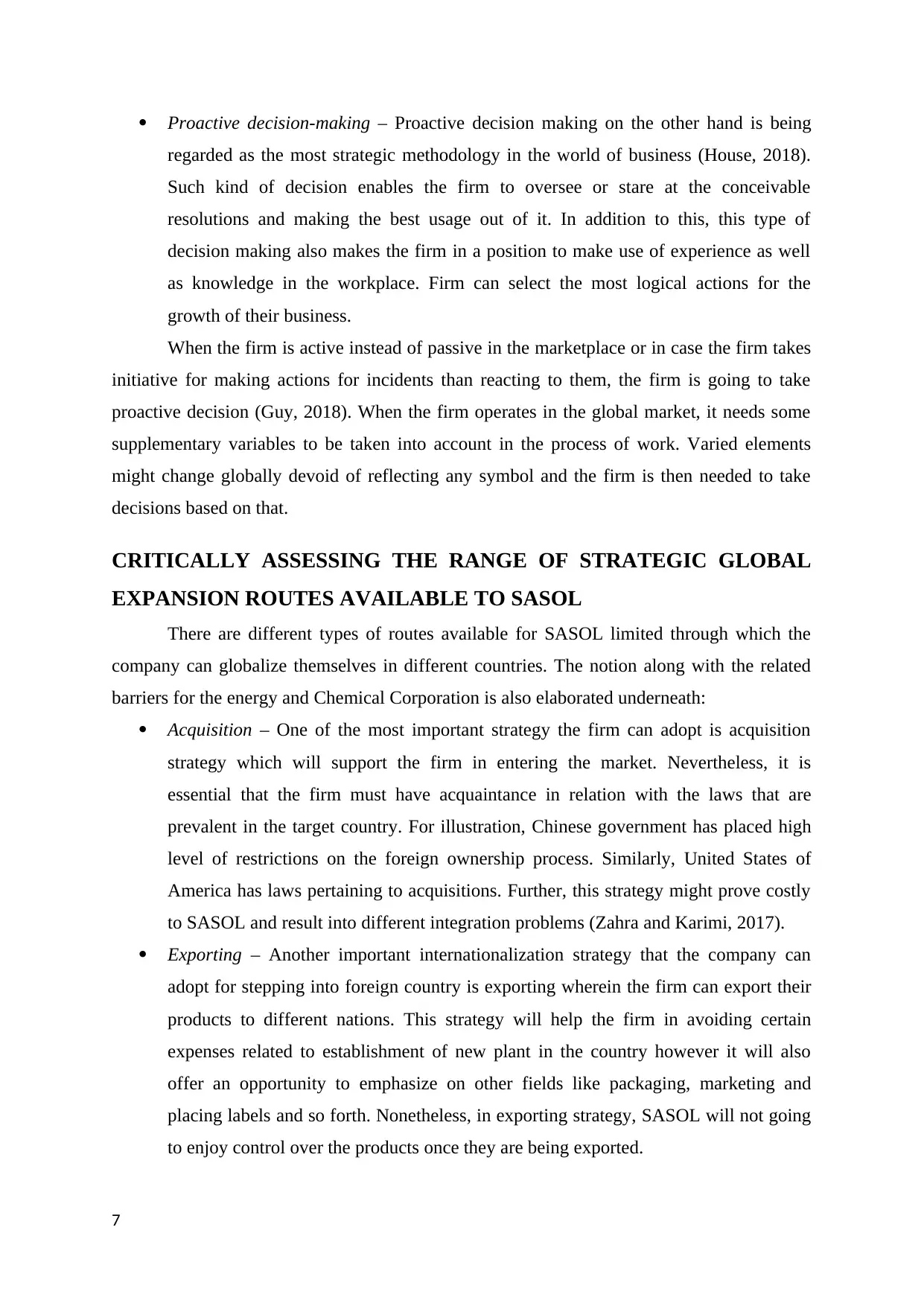
Proactive decision-making – Proactive decision making on the other hand is being
regarded as the most strategic methodology in the world of business (House, 2018).
Such kind of decision enables the firm to oversee or stare at the conceivable
resolutions and making the best usage out of it. In addition to this, this type of
decision making also makes the firm in a position to make use of experience as well
as knowledge in the workplace. Firm can select the most logical actions for the
growth of their business.
When the firm is active instead of passive in the marketplace or in case the firm takes
initiative for making actions for incidents than reacting to them, the firm is going to take
proactive decision (Guy, 2018). When the firm operates in the global market, it needs some
supplementary variables to be taken into account in the process of work. Varied elements
might change globally devoid of reflecting any symbol and the firm is then needed to take
decisions based on that.
CRITICALLY ASSESSING THE RANGE OF STRATEGIC GLOBAL
EXPANSION ROUTES AVAILABLE TO SASOL
There are different types of routes available for SASOL limited through which the
company can globalize themselves in different countries. The notion along with the related
barriers for the energy and Chemical Corporation is also elaborated underneath:
Acquisition – One of the most important strategy the firm can adopt is acquisition
strategy which will support the firm in entering the market. Nevertheless, it is
essential that the firm must have acquaintance in relation with the laws that are
prevalent in the target country. For illustration, Chinese government has placed high
level of restrictions on the foreign ownership process. Similarly, United States of
America has laws pertaining to acquisitions. Further, this strategy might prove costly
to SASOL and result into different integration problems (Zahra and Karimi, 2017).
Exporting – Another important internationalization strategy that the company can
adopt for stepping into foreign country is exporting wherein the firm can export their
products to different nations. This strategy will help the firm in avoiding certain
expenses related to establishment of new plant in the country however it will also
offer an opportunity to emphasize on other fields like packaging, marketing and
placing labels and so forth. Nonetheless, in exporting strategy, SASOL will not going
to enjoy control over the products once they are being exported.
7
regarded as the most strategic methodology in the world of business (House, 2018).
Such kind of decision enables the firm to oversee or stare at the conceivable
resolutions and making the best usage out of it. In addition to this, this type of
decision making also makes the firm in a position to make use of experience as well
as knowledge in the workplace. Firm can select the most logical actions for the
growth of their business.
When the firm is active instead of passive in the marketplace or in case the firm takes
initiative for making actions for incidents than reacting to them, the firm is going to take
proactive decision (Guy, 2018). When the firm operates in the global market, it needs some
supplementary variables to be taken into account in the process of work. Varied elements
might change globally devoid of reflecting any symbol and the firm is then needed to take
decisions based on that.
CRITICALLY ASSESSING THE RANGE OF STRATEGIC GLOBAL
EXPANSION ROUTES AVAILABLE TO SASOL
There are different types of routes available for SASOL limited through which the
company can globalize themselves in different countries. The notion along with the related
barriers for the energy and Chemical Corporation is also elaborated underneath:
Acquisition – One of the most important strategy the firm can adopt is acquisition
strategy which will support the firm in entering the market. Nevertheless, it is
essential that the firm must have acquaintance in relation with the laws that are
prevalent in the target country. For illustration, Chinese government has placed high
level of restrictions on the foreign ownership process. Similarly, United States of
America has laws pertaining to acquisitions. Further, this strategy might prove costly
to SASOL and result into different integration problems (Zahra and Karimi, 2017).
Exporting – Another important internationalization strategy that the company can
adopt for stepping into foreign country is exporting wherein the firm can export their
products to different nations. This strategy will help the firm in avoiding certain
expenses related to establishment of new plant in the country however it will also
offer an opportunity to emphasize on other fields like packaging, marketing and
placing labels and so forth. Nonetheless, in exporting strategy, SASOL will not going
to enjoy control over the products once they are being exported.
7
⊘ This is a preview!⊘
Do you want full access?
Subscribe today to unlock all pages.

Trusted by 1+ million students worldwide
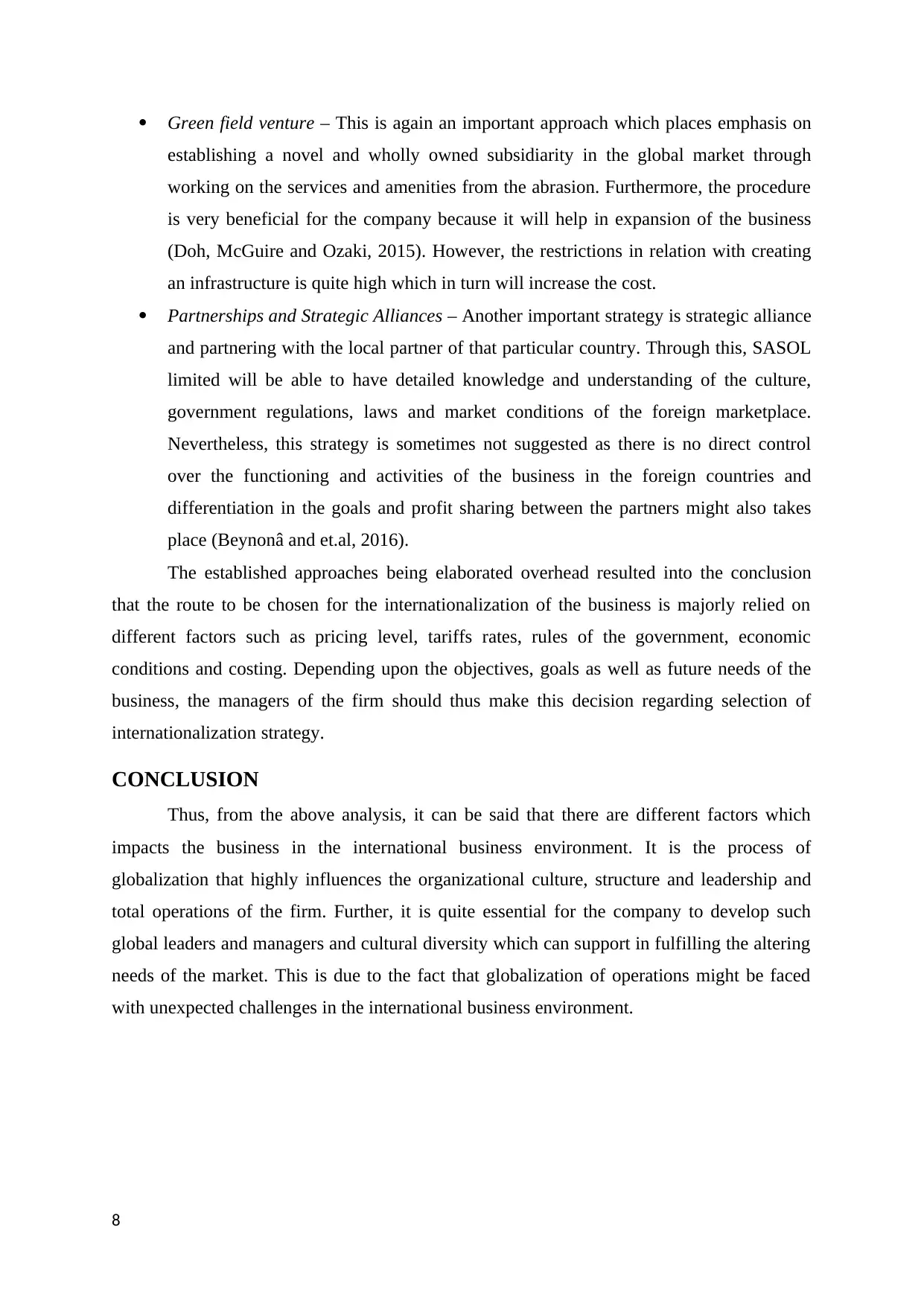
Green field venture – This is again an important approach which places emphasis on
establishing a novel and wholly owned subsidiarity in the global market through
working on the services and amenities from the abrasion. Furthermore, the procedure
is very beneficial for the company because it will help in expansion of the business
(Doh, McGuire and Ozaki, 2015). However, the restrictions in relation with creating
an infrastructure is quite high which in turn will increase the cost.
Partnerships and Strategic Alliances – Another important strategy is strategic alliance
and partnering with the local partner of that particular country. Through this, SASOL
limited will be able to have detailed knowledge and understanding of the culture,
government regulations, laws and market conditions of the foreign marketplace.
Nevertheless, this strategy is sometimes not suggested as there is no direct control
over the functioning and activities of the business in the foreign countries and
differentiation in the goals and profit sharing between the partners might also takes
place (Beynonâ and et.al, 2016).
The established approaches being elaborated overhead resulted into the conclusion
that the route to be chosen for the internationalization of the business is majorly relied on
different factors such as pricing level, tariffs rates, rules of the government, economic
conditions and costing. Depending upon the objectives, goals as well as future needs of the
business, the managers of the firm should thus make this decision regarding selection of
internationalization strategy.
CONCLUSION
Thus, from the above analysis, it can be said that there are different factors which
impacts the business in the international business environment. It is the process of
globalization that highly influences the organizational culture, structure and leadership and
total operations of the firm. Further, it is quite essential for the company to develop such
global leaders and managers and cultural diversity which can support in fulfilling the altering
needs of the market. This is due to the fact that globalization of operations might be faced
with unexpected challenges in the international business environment.
8
establishing a novel and wholly owned subsidiarity in the global market through
working on the services and amenities from the abrasion. Furthermore, the procedure
is very beneficial for the company because it will help in expansion of the business
(Doh, McGuire and Ozaki, 2015). However, the restrictions in relation with creating
an infrastructure is quite high which in turn will increase the cost.
Partnerships and Strategic Alliances – Another important strategy is strategic alliance
and partnering with the local partner of that particular country. Through this, SASOL
limited will be able to have detailed knowledge and understanding of the culture,
government regulations, laws and market conditions of the foreign marketplace.
Nevertheless, this strategy is sometimes not suggested as there is no direct control
over the functioning and activities of the business in the foreign countries and
differentiation in the goals and profit sharing between the partners might also takes
place (Beynonâ and et.al, 2016).
The established approaches being elaborated overhead resulted into the conclusion
that the route to be chosen for the internationalization of the business is majorly relied on
different factors such as pricing level, tariffs rates, rules of the government, economic
conditions and costing. Depending upon the objectives, goals as well as future needs of the
business, the managers of the firm should thus make this decision regarding selection of
internationalization strategy.
CONCLUSION
Thus, from the above analysis, it can be said that there are different factors which
impacts the business in the international business environment. It is the process of
globalization that highly influences the organizational culture, structure and leadership and
total operations of the firm. Further, it is quite essential for the company to develop such
global leaders and managers and cultural diversity which can support in fulfilling the altering
needs of the market. This is due to the fact that globalization of operations might be faced
with unexpected challenges in the international business environment.
8
Paraphrase This Document
Need a fresh take? Get an instant paraphrase of this document with our AI Paraphraser
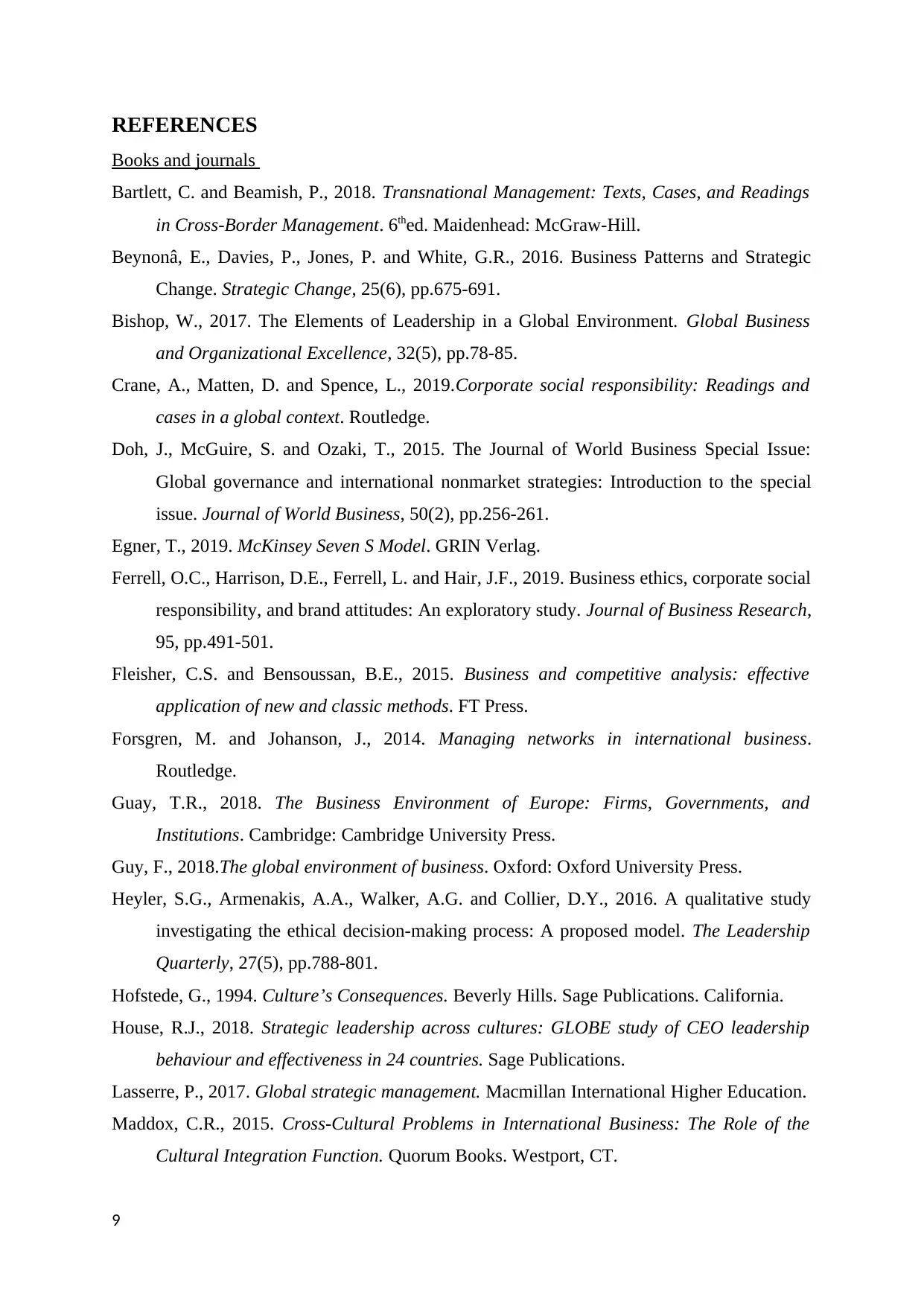
REFERENCES
Books and journals
Bartlett, C. and Beamish, P., 2018. Transnational Management: Texts, Cases, and Readings
in Cross-Border Management. 6thed. Maidenhead: McGraw-Hill.
Beynonâ, E., Davies, P., Jones, P. and White, G.R., 2016. Business Patterns and Strategic
Change. Strategic Change, 25(6), pp.675-691.
Bishop, W., 2017. The Elements of Leadership in a Global Environment. Global Business
and Organizational Excellence, 32(5), pp.78-85.
Crane, A., Matten, D. and Spence, L., 2019.Corporate social responsibility: Readings and
cases in a global context. Routledge.
Doh, J., McGuire, S. and Ozaki, T., 2015. The Journal of World Business Special Issue:
Global governance and international nonmarket strategies: Introduction to the special
issue. Journal of World Business, 50(2), pp.256-261.
Egner, T., 2019. McKinsey Seven S Model. GRIN Verlag.
Ferrell, O.C., Harrison, D.E., Ferrell, L. and Hair, J.F., 2019. Business ethics, corporate social
responsibility, and brand attitudes: An exploratory study. Journal of Business Research,
95, pp.491-501.
Fleisher, C.S. and Bensoussan, B.E., 2015. Business and competitive analysis: effective
application of new and classic methods. FT Press.
Forsgren, M. and Johanson, J., 2014. Managing networks in international business.
Routledge.
Guay, T.R., 2018. The Business Environment of Europe: Firms, Governments, and
Institutions. Cambridge: Cambridge University Press.
Guy, F., 2018.The global environment of business. Oxford: Oxford University Press.
Heyler, S.G., Armenakis, A.A., Walker, A.G. and Collier, D.Y., 2016. A qualitative study
investigating the ethical decision-making process: A proposed model. The Leadership
Quarterly, 27(5), pp.788-801.
Hofstede, G., 1994. Culture’s Consequences. Beverly Hills. Sage Publications. California.
House, R.J., 2018. Strategic leadership across cultures: GLOBE study of CEO leadership
behaviour and effectiveness in 24 countries. Sage Publications.
Lasserre, P., 2017. Global strategic management. Macmillan International Higher Education.
Maddox, C.R., 2015. Cross-Cultural Problems in International Business: The Role of the
Cultural Integration Function. Quorum Books. Westport, CT.
9
Books and journals
Bartlett, C. and Beamish, P., 2018. Transnational Management: Texts, Cases, and Readings
in Cross-Border Management. 6thed. Maidenhead: McGraw-Hill.
Beynonâ, E., Davies, P., Jones, P. and White, G.R., 2016. Business Patterns and Strategic
Change. Strategic Change, 25(6), pp.675-691.
Bishop, W., 2017. The Elements of Leadership in a Global Environment. Global Business
and Organizational Excellence, 32(5), pp.78-85.
Crane, A., Matten, D. and Spence, L., 2019.Corporate social responsibility: Readings and
cases in a global context. Routledge.
Doh, J., McGuire, S. and Ozaki, T., 2015. The Journal of World Business Special Issue:
Global governance and international nonmarket strategies: Introduction to the special
issue. Journal of World Business, 50(2), pp.256-261.
Egner, T., 2019. McKinsey Seven S Model. GRIN Verlag.
Ferrell, O.C., Harrison, D.E., Ferrell, L. and Hair, J.F., 2019. Business ethics, corporate social
responsibility, and brand attitudes: An exploratory study. Journal of Business Research,
95, pp.491-501.
Fleisher, C.S. and Bensoussan, B.E., 2015. Business and competitive analysis: effective
application of new and classic methods. FT Press.
Forsgren, M. and Johanson, J., 2014. Managing networks in international business.
Routledge.
Guay, T.R., 2018. The Business Environment of Europe: Firms, Governments, and
Institutions. Cambridge: Cambridge University Press.
Guy, F., 2018.The global environment of business. Oxford: Oxford University Press.
Heyler, S.G., Armenakis, A.A., Walker, A.G. and Collier, D.Y., 2016. A qualitative study
investigating the ethical decision-making process: A proposed model. The Leadership
Quarterly, 27(5), pp.788-801.
Hofstede, G., 1994. Culture’s Consequences. Beverly Hills. Sage Publications. California.
House, R.J., 2018. Strategic leadership across cultures: GLOBE study of CEO leadership
behaviour and effectiveness in 24 countries. Sage Publications.
Lasserre, P., 2017. Global strategic management. Macmillan International Higher Education.
Maddox, C.R., 2015. Cross-Cultural Problems in International Business: The Role of the
Cultural Integration Function. Quorum Books. Westport, CT.
9
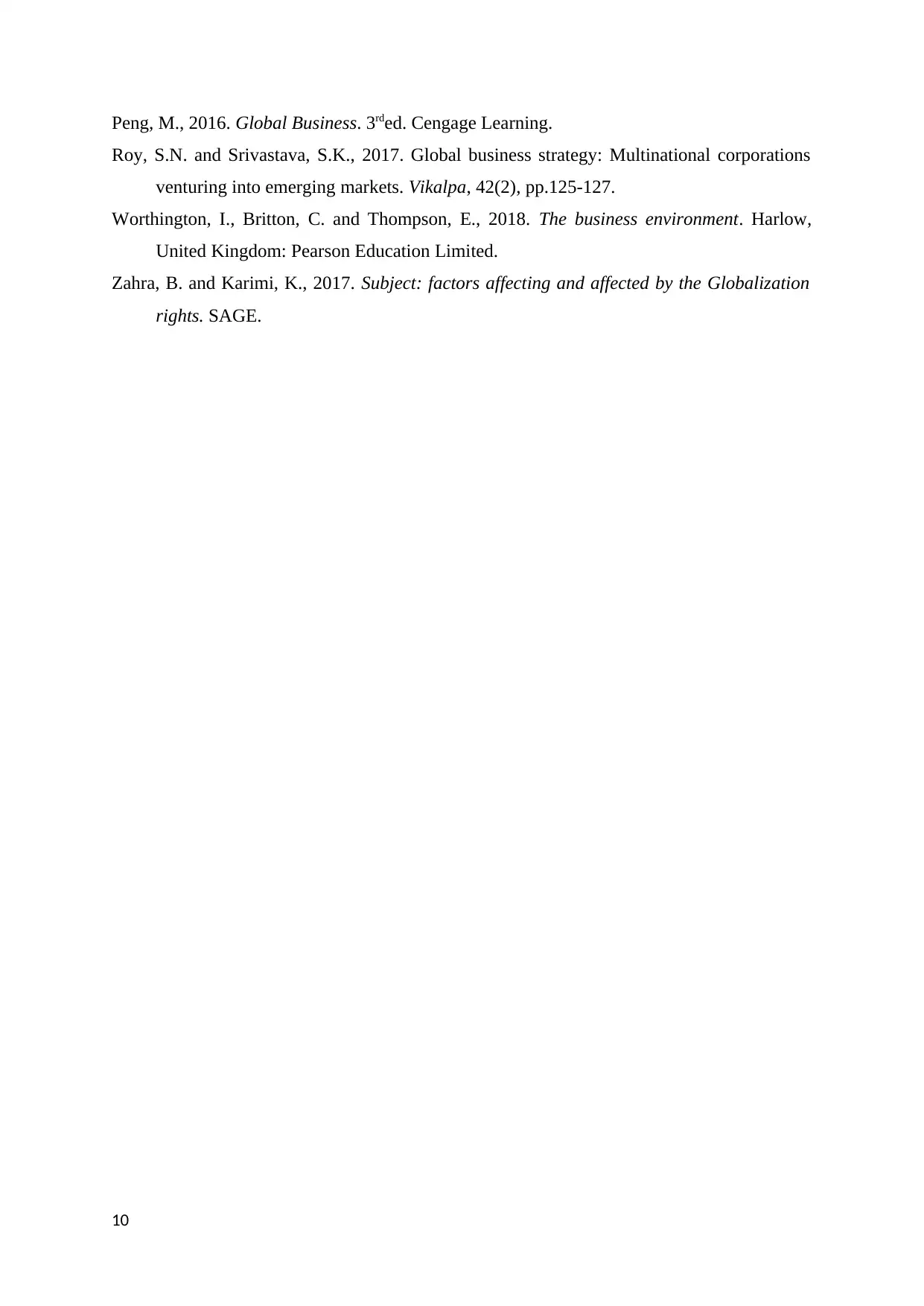
Peng, M., 2016. Global Business. 3rded. Cengage Learning.
Roy, S.N. and Srivastava, S.K., 2017. Global business strategy: Multinational corporations
venturing into emerging markets. Vikalpa, 42(2), pp.125-127.
Worthington, I., Britton, C. and Thompson, E., 2018. The business environment. Harlow,
United Kingdom: Pearson Education Limited.
Zahra, B. and Karimi, K., 2017. Subject: factors affecting and affected by the Globalization
rights. SAGE.
10
Roy, S.N. and Srivastava, S.K., 2017. Global business strategy: Multinational corporations
venturing into emerging markets. Vikalpa, 42(2), pp.125-127.
Worthington, I., Britton, C. and Thompson, E., 2018. The business environment. Harlow,
United Kingdom: Pearson Education Limited.
Zahra, B. and Karimi, K., 2017. Subject: factors affecting and affected by the Globalization
rights. SAGE.
10
⊘ This is a preview!⊘
Do you want full access?
Subscribe today to unlock all pages.

Trusted by 1+ million students worldwide
1 out of 12
Related Documents
Your All-in-One AI-Powered Toolkit for Academic Success.
+13062052269
info@desklib.com
Available 24*7 on WhatsApp / Email
![[object Object]](/_next/static/media/star-bottom.7253800d.svg)
Unlock your academic potential
Copyright © 2020–2025 A2Z Services. All Rights Reserved. Developed and managed by ZUCOL.

